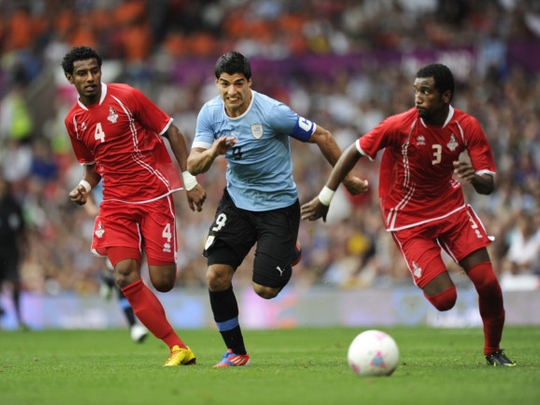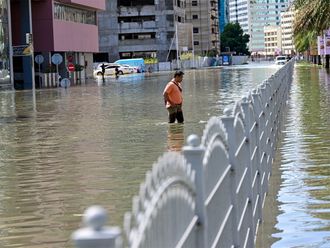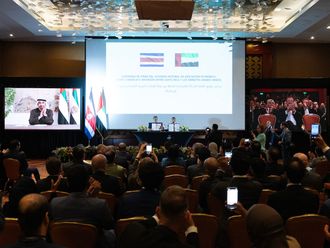
As the net furled on impact from Esmail Al Hammadi’s 107th-minute extra-time winning strike against Iraq, the UAE’s footballing adolescence was pushed aside by its long-awaited coming of age.
The unbridled euphoria writ large on the faces of players, coaches, fans and leaders of the Falcon nation, as Ali Khasif clenched the Gulf Cup of Nations trophy adoringly and hoisted it into the floodlit Manama night sky in January, bespoke an emotional adulation rarely seen in any Middle Eastern sports tournament and leaves no doubt as to the poignancy and potential of football in this country.
The UAE’s Gulf Cup triumph came hot on the heels of their impressive showing at London 2012 against three established footballing nations: Great Britain, Uruguay and Senegal. Despite missing out on qualification for Rio 2014, the country expects to be watching their football stars in Russia in 2018 for the Fifa World Cup.
It is usually the case that success on the national stage mirrors a thriving domestic set-up. Take Germany and Spain as examples. But while the beautiful game is far and away the most popular sport in the UAE, the choice coterie of players representing the national team brushes a veneer of respectable credibility over a domestic scene in need of much improvement.
Stumbling blocks
Notoriously poor attendance figures at matches, a preference for watching European giants such as Barcelona, Real Madrid and Manchester United instead of local clubs, and an extrinsically motivated dressing room culture are some of the biggest hurdles the sport faces.
“As a young league currently in the early stages of our sixth season of professionalism, we have seen some huge changes year-on-year as we constantly learn and evolve,” Colin Smith, CEO of the Professional League Committee (PLC), tells GN Focus in an emailed statement.
“The standard on the pitch has seen a marked improvement since the start of the professional era; the quality and professionalism of Emirati players have increased drastically; our attendances — though still an area we need to further develop — are going up at a healthy rate; and the general awareness of our league and our players continues to expand internationally.”
When the UAE Football Association (UAE FA) started its march towards professionalism under a mandate promulgated by the Asian Football Confederation (AFC) that aimed to improve the standard of football in the region, the UAE stood out as a benchmark for the region, says Carlo Nohra, Chief Executive of the UAE Football League (UFL) between 2010 and 2011 (when it was dissolved).
“For football to grow there had to be a greater focus on clubs because that’s the cradle of development. In 2005, [then] President of the AFC, Mohammad Bin Hammam, initiated and launched the professionalisation project,” he tells GN Focus.
The project established a definition of professionalism that the national associations had to be willing to commit to.
The AFC required that leagues adhering to its vision should be independent legal entities operating under the wing of the relevant football association — the aim was to give clubs the space to run and manage their own affairs, thus encouraging a self-sustainable progressiveness.
Major metamorphosis
Nohra, also formerly Director of Competitions at the AFC, adds: “The UAE was a model association as far as the AFC was concerned in that it was willing to take that leap of faith and form an independent organisation, which they did in 2009.”
The inception of the independently run UFL saw football moving in the right direction as for two years between 2009 and 2011 the UFL operated autonomously and in sync with the UAE FA, raising awareness of the game and supporting clubs in the push towards professionalism.
The UAE’s football system effectively transformed from just a single amateur body into two professional bodies. One of which, the UFL, was in charge of professionalising the sport, while the other, the UAE FA, remained in limbo after giving away a major component of their identity to the new organisation. This is no different to how football associations and leagues operate around the world, but it took some getting used to.
“It was time for the UAE to undergo the same transformation that other countries’ [football leagues] have. This was all a natural part of the growth we were undergoing at the time,” Nohra says.
But in 2011 the UFL was dissolved and the entire remit of the independently functioning body was re-assigned to the UAE FA under the PLC, because of “a lack of dialogue between the two bodies,” according to Nohra.
“We were working our way towards being the genuine governing body of the professional league playing a regulatory role. I don’t see any of that happening anymore. I don’t see how the league is helping the clubs anymore.
“In my opinion, we reached a peak of progression in 2011 and now the league is experiencing a regression. Others may say it’s plateaued,” says Nohra, who, since his tenure at the UFL, has held Chief Executive roles at Al Jazira and Al Ain.
Game changers
The league was renamed the UAE Pro League, and has since changed again this year to the Arabian Gulf League, in what is seen as being a political move over the disputed Gulf waters.
Asked how the PLC, UAE FA and the Arabian Gulf League’s relationship works today to further football, Smith says: “Ultimately we are all working together towards the same aim, which is to develop and strengthen football in the UAE at all levels.
“We have seen great improvements from our clubs operationally and technically since the introduction of Club Licensing in January 2012, ensuring that all our clubs meet AFC criteria and are functioning to the level required not only by the league, but by the [AFC], and as our clubs continue to become better versed with the Club Licensing requirements we envisage this having a positive impact on the standard of football.”
Aside from footballing admin, one of the most important facets of driving the professional ethos of football in the UAE is player development.
While nurturing a pool of potential Emirati stars capable of representing the foot-savvy Falcons to tackle the world’s best international XIs on the field, there is a debate rumbling in soccer circles over whether more expatriates and foreign players should be eligible to train and play with club sides and the consequent impact on Emirati talent.
“There’s an ethical responsibility of a football club to develop young people as well as just players and I don’t think that has really developed yet,” says Tim March, former Sharjah FC General Football Coordinator.
“I think players here are motivated by gain. The problem is that we don’t have a strong enough education system and academy set-up to inoculate them against other factors when they become professional like the riches and wealth and rewards they see as part and parcel of the lifestyle.
“That’s one of the big issues facing [UAE football], and it’s one of the reasons that we have players at 17 and 18 who don’t necessarily develop into professional players, because to do it as a job, it requires a lot of character and education: some of the most talented players at 17 just disappear,” March explains.
Local talent or international experience?
Developing local talent is a key focus for Fahad Hadi, Board Member at Al Nasr FC, who says better-funded and organised academy structures are better for the game than forking out extortionate sums on overseas players.
“If you have cash you can buy good players. Or you have to invest in your academy. We at [Al Nasr] choose to invest in our academy because these are the players we want playing for our team.
“We want to have six or seven, maybe more, players in the first team that we have developed ourselves from our academy,” Hadi tells GN Focus.
Al Nasr famously acquired the services of 65-year-old Sven Goran Eriksson, former England national team coach, in January to help identify the club’s young talent and advise on academy structures.
Eriksson’s stint came to a premature end after four months when he left to coach Chinese club side Guangzhou R&F, despite signing an 18-month contract with Nasr. But Hadi was happy with the Swede’s involvement with the club.
“When Eriksson was here he gave us a perfect report about our academy. He told us which players to put an eye on for the future and did some very good work that helped us a lot,” he says.
Turning to the players themselves, one change Hadi feels imperative for footballers in the UAE is their attitude towards professionalism, which he says is en bloc “not up to expected standards.
“We have to change the culture of the players. If you compare our players with professionals from other leagues such as Germany and England — even mid-league European teams — you can see the differences very clearly. Those players there know when to eat, when to sleep, even how to talk to the media. Our players still have a lot of steps to take to reach the type of professionalism that we are talking about having in this country,” he says.
Community reach
One way of improving club academy structures and thereby the standard of professionalism inherent within them, March suggests, is by introducing community projects that include expatriates. Hitherto, football-minded expats train at private academies because of the limitations on them in UAE club sides.
“Many expatriates go to private academies which will often have better qualified coaches than the pro clubs. We need inclusive academy models that engage as much as possible with the community,” March explains. “It would increase the standard, increase competition for places — especially for local players, they’ll value the shirt more, it’ll pull their level up and, critically, it will increase the community reach of clubs.”
March’s point drives home the notion that playground and shisha bar football talk in the UAE focuses on the European Champions League sides such as Barcelona, Bayern Munich and Manchester United rather than Al Ain and Sharjah FC.
“If you’ve got kids at schools involved in the pro clubs, it will create a discussion about local football in school playgrounds, which is what we need. We need everyday discussions about Sharjah, Al Jazira, Al Ain: it would be nice to hear kids talking about the UAE fixtures,” he says.
International football superstars such as Luca Toni and Asamoah Gyan have done much to raise the profile and, in certain cases, the standard of football in the UAE.
Currently teams are allowed four foreign players in their side, as per AFC regulations. The mix has done well for the sport, and, Smith says, “there are no plans at present to change the rules regarding squad structure, as we find the current balance to be working well.
“There is a healthy ratio of goals scored per round by Emirati players compared to foreign players, and the existing set-up promotes the development and progression of Emirati talent while also allowing a good proportion of overseas players to bring their skills to our league.”












